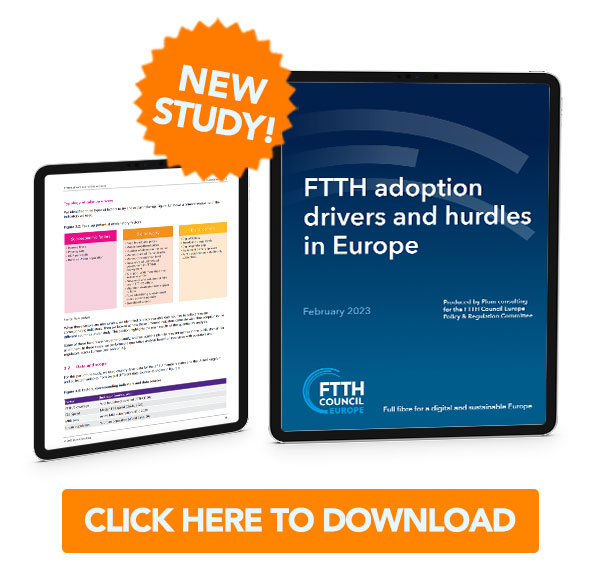FTTH Adoption: A Key Policy Challenge for Europe
To pursue its mission to advance ubiquitous full fibre-based connectivity to the whole of Europe, the FTTH Council Europe has identified the key factors that the decision-makers and market players should keep in mind when shaping policy measures and business strategies aimed at boosting the take-up.
Based on a study carried out by Plum Consulting on FTTH adoption drivers and hurdles in Europe, the FTTH Council Europe observes that FTTH/B coverage is a key driver of take-up. Countries with low coverage overall tend to have low take-up rates. Coverage is to some extent also driven by take-up, because successful fibre network operation is likely to find it easier to fund further development. There is likely a virtuous cycle where deployment drives take-up, which in return encourages rapid deployment. The reverse may also be true, as poor take-up may slow deployment.
There is a relatively strong negative correlation between take-up and the price of very-high speed broadband. Pricing is indeed all important. Not only is the price difference between legacy offers and FTTH/B important in creating attractiveness for fibre offers, but the relative price difference with the alternative solutions, e.g. mobile offers, if too significant, can also push users towards mobile substitution solutions. In other words, when FTTH/B services are too expensive, some customers tend to prefer a less expensive mobile broadband-only form of connectivity.
Socioeconomic factors, such as digital literacy, do not seem to be a key driver for FTTH take-up. Yet this does not imply that digital literacy is not a crucial aspect of participation in socioeconomic processes. The situation varies greatly among countries, and the study provides more insights about countries where it is a clear hurdle (e.g. Poland). Addressing socioeconomic factors should remain a high priority.
Focus on deployment of FTTC or Docsis 3.1 in the last decade is the biggest hurdle to FTTH/B adoption. Differentiation is harder for FTTH/B offers and consumers are often less eager to upgrade to fibre. This situation is made worse when advertising rules have allowed market players to sell FTTC and/or cable as “fibre”. [1]
The FTTH Council Europe also observes that in markets where the dominant FTTH/B delivery model is through wholesale platforms, the participation of national brands to this dynamic can make a significant difference in adoption.
FTTH Council Europe policy recommendations to boost take-up in Europe
Governments pushing for the deployment of FTTH/B networks should target demand side policy schemes exclusively towards FTTH/B adoption. In other words, deployment and adoption goals should be aligned:
- Voucher schemes and associated programs designed to facilitate broadband adoption for low-income households should promote the best network solution available in a given location. If that solution is a FTTH/B one, only that solution should be included in the scheme.
- While income can be a strong hurdle, it is often combined with digital literacy issues. Programs designed to facilitate adoption for households with limited digital literacy and long-term digital education can make a lasting difference. Some of the public funding targeted at vouchers could be more effectively allocated to accompaniment programs that would help low literacy populations shift to FTTH/B.
- Governments, particularly local governments, can encourage FTTH/B adoption through anchor tenancy and awareness. Too often, local governments are willing to switch their own digital needs over to FTTH/B networks but don't explain to the population why, and what benefits they will derive from it.
- Awareness can also be addressed through clear advertising rules. Networks that are end-to-end fibre should be able to differentiate from solutions that are not. In some markets, the word "Fibre" can still be used in advertising for FTTC or cable solutions.
- Explore possible tax incentives to encourage the FTTH/B adoption.
A second set of recommendations are addressing several market related aspects:
- The study observes that some countries are looking at regulated wholesale prices of copper and the price gap between that and wholesale prices of fibre. Copper pricing changes create a set of paradoxical incentives: increasing the price of regulated copper would increase prices and create a market incentive to shift to fibre, but would also increase incumbent revenues, creating an opposite incentive to preserve that additional revenue. If used, this lever would need to be geographically targeted in areas where FTTH/B are already available and applied dynamically as access conditions change.
- Any distinct geographical areas where FTTH/B adoption is over 50% should have plans in place to manage the gradual switching off of copper assets. This should be done in a way that does not favour the incumbent commercially, but still allow, or indeed encourage the migration of customers to a fibre platform. A clearly delineated copper switch-off policy will mechanically boost FTTH/B adoption as customers become aware of a deadline to adopt alternative solutions for their broadband needs.
While the current work within the FTTH Council Europe and the study by Plum Consulting has focused on the recommendations for policy makers, there are many aspects related to network providers that also need to be addressed. This might be a subject of future work by the FTTH Council Europe. Beyond the actions that can be taken at a political level, the market players clearly need to do their own part to eliminate hurdles that hinder FTTH/B adoption.
Click here to download the full FTTH Council Europe position on the FTTH/B take-up in Europe
Click here to dowloand the full study on the FTTH/B drivers and hurdles in Europe, prepared by Plum Consulting